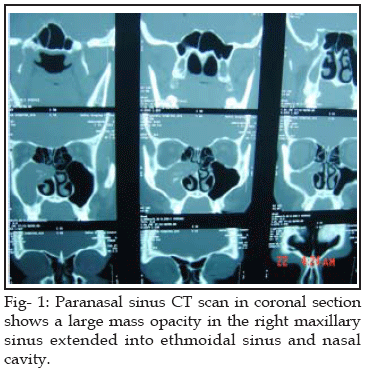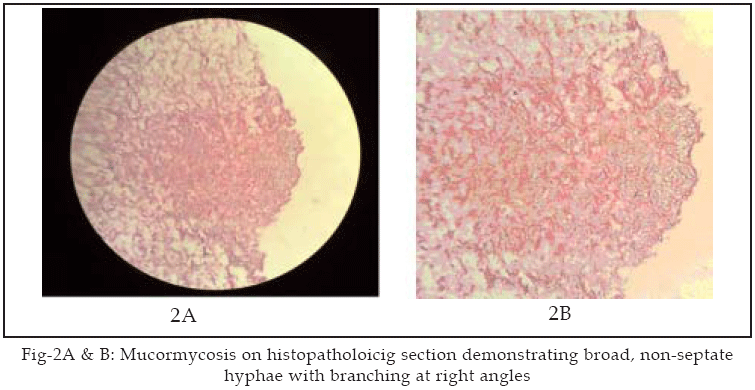|
|
||||
|
Published by : PROFESSIONAL MEDICAL PUBLICATIONS |
||||
|
ISSN 1681-715X |
||||
|
||||
|
- |
||||
|
CASE REPORT |
||||
|
- |
||||
|
Volume 25 |
October - December 2009 (Part-I) |
Number 5 |
||
|
|
||||
|
|
||||
|
|
||||
|
Published by : PROFESSIONAL MEDICAL PUBLICATIONS |
||||
|
ISSN 1681-715X |
||||
|
||||
|
- |
||||
|
CASE REPORT |
||||
|
- |
||||
|
Volume 25 |
October - December 2009 (Part-I) |
Number 5 |
||
|
|
||||
|
|
||||
Maxillary Sinus mucormycosis
mimicking sinus malignancy
Ghodrat Mohammadi1
ABSTRACT
Mucormycosis is an opportunistic fulminant fungal infection in diabetic and immunocompromised patients. The infection is acquired in the nose and paranasal sinuses by the inhalation of the fungal spores. We report of a case of maxillary sinus mucormycosis in a 32-years-old non diabetic woman. She had right side facial pain, headache, unilateral right side nasal obstruction, and post nasal discharge (PND) for five years. Nasal endoscopy revealed pus and granulation tissue, and semi-black middle turbinate in right side nasal cavity. Computed tomography showed bone erosion and a large soft tissue mass similar to sinus carcinoma in maxillary sinus with extension into the ethmoidal sinus. She underwent functional Endoscopic sinus surgery. Macroscopically, the specimen consisted of multiple tissue fragment 0.8-1 cm. Microscopic findings included an inflammatory cells and deposited fungal elements (mucormycosis). So in the paranasal sinus and nasal cavity mass, mucormycosis should be included in the differential diagnosis, especially in the non diabetic and young patients.
KEYWORDS
: Mucormycosis, Fungal Sinusitis, Sinus carcinoma.Pak J Med Sci October - December 2009 (Part-I) Vol. 25 No. 5 872-874
How to cite this article:
Mohammadi G. Maxillary Sinus mucormycosis mimicking sinus malignancy. Pak J Med Sci 2009;25(5):872-874.
1. Ghodrat Mohammadi, MD
Associate Professor,
Department of Oto-rhino-laryngology,
Tabriz University (Medical Science),
Tabriz – Iran.
Correspondence:
Dr. Ghodrat Mohammadi
E-Mail : mohammadig@yahoo.co.nz
* Received for Publication: January17, 2009
* Accepted for Publication: July 29th 2009
INTRODUCTION
Mucormycosis is a rare fungal infection that has a predilection for the rhinocrebral and, to a less extent, the pulmonary area.
1 Rarely has mucormycosis been reported in apparently healthy individuals.2 Mucormycosis is prone to occur in patients’ already debilitated from a pre-existing disease, e.g., AIDS, or uncontrolled diabetes, or those under cancer chemotherapy or immunosuppressive therapy.3-4 The disease has a worldwide distribution without age or race preference. Men are affected slightly more than women. There is no occupational predilection or seasonal variation. The standard treatment of this disease is administration of high dose amphotericin B and wide surgical excision with safe margin.5 Herein, we report on a mass in maxillary sinus that was proved by pathologist as sinus mucormycosis in a 32-years-old non diabetic women mimicking carcinoma of the maxillary sinus on the CT scan and intra-operatively.CASE REPORT
A 32-years-old non diabetic woman was admitted to Shahriar Hospital in Tabriz, Iran in December 2007 with history of five years right side facial pain, headache, unilateral right side nasal obstruction, and post nasal discharge (PND). She had received oral and intravenous antibiotics for four weeks without any improvements. On admission, the patient had right side pain on the face and mild epistaxis. She was not febrile. She had right side nasal obstruction. Laboratory findings were normal. Bacteriologic examination of the sputum was normal. Computed tomography Scan revealed a large soft tissue mass inside the right side maxillary sinus that extended into the anterior ethmoidal sinus and nasal cavity with erosion and widening of maxillary sinus ostium suggestive for malignancy or inverted Papilloma (Figure-1). Endonasal endoscopy revealed pus and granulation tissue, and semi-black middle turbinate in right side nasal cavity.

Because of suspicion for malignancy and mucorumycosis, the patient underwent endonasal endoscopic sinus surgery, and all spicemen were taken from nasal cavity and sinus sent to pathology laboratory. Pathology reports was mucorumycosis with broad, non-septate hyphae with branching at right angles (Figure-2). Then nasal cavity and sinus were completely debrided and amphotricin B was started. Intranasal examinations showed no evidence of disease six month after debridment.

DISCUSSION
Paranasal sinus mucormycosis is an opportunistic disease and highly invasive fungal infection in human which usually begins in the nose and paranasal sinuses, that is extremely important to otolaryngologist.
1 Mucormycosis occurs in patients already debilitated from a preexisting disease , e.g., AIDS, or uncontrolled diabetes, or those under immunosuppressive therapy, patients receiving renal dialysis and desferrioxamine are also at increased risk for mucormycosis, but can infect healthy individuals as well.3-4 In this case there were no such risk factors and patient was a healthy woman.The diagnosis was based on clinical features, radiographic findings (CT Scan and MRI), and histopathological picture. Clinical manifestations of invasive mucormycosis differ depending on the site of invasion. Reported sites of infection include the nose, lungs, gastrointestinal tract, skin, kidneys, and central nervous system.
6 In the maxillary sinus, dark blood tinged nasal discharge, headache, facial pain, anesthesia of the affected side, and black necrotic turbinate are the Clinical Presentation. Typical finding of paranasal mucormycosis on Computed Tomography (CT) Scan include mucoperiosteal edema of the sinuses associated with bony destruction.8 But mucormycosis seen only in maxillary sinus with bone erosion in a non diabetic female, mimicking the malignancy and inverted Papilloma is unusual and rare. A definitive diagnosis of mucormycosis can be made by tissue biopsy that identifies the characteristic broad, non-septate hyphae with branching at right angles and arterial, veins and lymphatic’s thrombosis, edema, and hemorrhagic necrosis are seen in the microscopic picture.7 Even when the clinical suspicious is high, the disease is commonly confused with other chronic supportive sinus disease and malignancy. So it is deserve attention because of the difficulty in differentiating it diagnosis from malignancy.Management of mucormycosis requires high suspicion and early diagnosis. Investigation for diagnosis include imaging modalities like CT or magnetic resonance imaging scans to look for sinus involvement or spread to contiguous structures. Definitive diagnosis can be obtained only from tissue biopsy. Once the diagnosis is suspected surgical debridement and amphotericin B therapy should be initiated.
CONCLUSIONS
In healthy and nondiabetic individuals mucormycosis is rare particularly in the maxillary sinus it is seldom seen. So in the paranasal sinus and nasal cavity mass, mucormycosis should be included in the differential diagnosis, especially in the non diabetic and young patients.
REFERENCES
1. Leitner C, Hoffmann J, Zerfowski M, Reinert S. mucoromycosis necrotizing soft tissue lesion of the face. J Oral Maxillofac Surg 2003;61:1354-8.
2. Neville, Damm, Allen, Bouquot, editors. Oral & Maxillofacial Pathology; 5th Edition, New Delhi, ELSEVIER A division of Reed Elsevier India Private Limited, 2006.
3. Rajendren R, Sivapathasundharam B, editors. Shafer’s Textbook of Oral Pathology; 5th edition, New Delhi, ELSEVIER A division of Reed Elsevier India Private Limited, 2006.
4. Cotran, Kumar, Robbin, editors. Robbin’s Pathologic Basis of Disease; 5th Edition, USA , W.B. Saunders Company, 1994.
5. Yousem DM, Galetta SL, Gusnard DA, Goldberg HI.MR findings in rhinocerebral mucormycosis. J Comput Assist Tomogr 1989; 13:878-882
6. Ferguson BJ. Mucormycosis of the nose and paranasal sinuses. Otolaryngol Clin North Am 2000;33:349–365.
7. Topley, Wilson, editors. Microbiology & Microbial Infections, Nineth Edition, Volume 4, New Delhi, ELSEVIER A division of Reed Elsevier India Private Limited, 2006.
8. Frederick M, McLean, Lawrence E. Ginsberg, and Constance A. perineural Spread of Rhinocerebral mucormycosis. AJNR:1996;17,114-116
HOME | SEARCH | CURRENT ISSUE | PAST ISSUES
Professional
Medical Publications
Room No. 522, 5th Floor, Panorama Centre
Building No. 2, P.O. Box 8766, Saddar, Karachi - Pakistan.
Phones : 5688791, 5689285 Fax : 5689860
pjms@pjms.com.pk